
Double A Sri Lanka rewards winners of ‘Friends of the Planet’ campaign
Back row (from left): Chethika Hapugalle, General Manager, Double A Pulp and Paper Company Sri Lanka; A.S. Hewage, Additional Secretary – School Activates – Ministry of Education; Thirawit Leetavorn, Vice President, Double A Pulp and Paper Company Limited; Akila Viraj Kariyawasam, Minister of Education; W.M. Bandusena, Secretary, Ministry of Education; M. J. J. Fernando, DDG – Environmental Education & Awareness Division, Central Environmental Authority; and Damayanthi Balasuriya Director of Education – Agriculture and Environmental Studies. Front row (from left): A. Thevakanthan (Project Teacher, Vincent Girls’ High School, Batticaloa), students Primraj Ravichandra, Abarna Kumarakuruparan, Litharshika Sadatchararajah, Thuwaraha Suntharalingam, Tharshana Thevaraj and Principal, Vincent Girls’ High School, Batticaloa R. Kanagasingam
Vincent Girls’ High School, Batticaloa emerged Overall Winners in the final round of the ‘Friends of the Planet’ project conducted by Double A in collaboration with the Ministry of Education and the Central Environmental Authority.
Mayurapada Central College, Narammala and Pallivasalthurai Muslim Maha Vidyalayam, Kalpitiya clinched second and third place respectively.
The awards ceremony was held recently at the Ministry of Education auditorium. The Chief Guest at the occasion was Education Minister Akila Viraj Kariyawasam. Also present were Prof. Lal Mervin Dharmasiri from the Central Environmental Authority and Thirawit Leetavorn, Senior Executive Vice President of the Double A (1991) Public Company Ltd.
Members of Vincent Girls’ High School, Batticaloa were given tablets and will be sent on an all-expenses-paid trip to Thailand where they will see the award-winning KHAN-NA sustainability project carried out by Double A.
The paper from the KHAN-NA project is a landmark effort to make optimum use of the vacant space between rice fields in Thailand, owned by local farmers. During the process, the KHAN-NA project’s previous unproductive land is transformed into a productive resource, which provides additional income to over 1.5 million farmers when they sell the sustainable fibre-source back to Double A.
The teams from Mayurapada Central College, Narammala and Pallivasalthurai Muslim Maha Vidyalayam, Kalpitiya received valuable tablets and certificates.
Double A ‘Friends of the Planet’ is a CSR project which was initiated in February 2016 to promote and educate schoolchildren island-wide on environmental protection. Seven schools were selected to implement their innovative projects under the guidance of the Ministry of Education Director of Education (Agriculture and Environmental Studies) and the Central Environmental Authority. This project was monitored by the Director of Education (Agriculture and Environmental Studies) and the Central Environmental Authority.
According to the campaign guidelines, the competing schools selected a team of five students above the age of 15 to come up with a cost-effective and groundbreaking solution to an environmental problem.
Under the guidance of a teacher, each team developed and implemented a project within a period of three months. Upon completing the project each team compiled a detailed report which they presented to the expert panel of judges from Double A for evaluation.
“We are pleased to announce the winners who, with their creativity and intellect, were able to craft solutions to larger problems and awareness of how important it is for everyone to band together to save the planet. Armed with innovative ideas, these students are important stakeholders in a new way of life that will help save the planet. Judging from the success of this particular campaign, our belief in young minds was well-founded,” said Leetavorn, who flew into Colombo for the ceremony.
Leetavorn is the Senior Executive Vice President of Double A. He is a key member of the team leading the global consumer expansion of the Double A brand. He currently leads market development for Europe and the Americas.

Biodiversity greater inside Earth’s protected areas
Biodiversity is greater inside the world’s protected areas, scientists have been able to show for the first time.
There are 15% more individual plants and animals and 11% more species inside than outside protected areas, according to the largest analysis of biodiversity in terrestrial globally protected areas to date.
The study, carried out by the University of Sussex, the Natural History Museum and the UN Environment Programme’s World Conservation Monitoring Centre, analysed biodiversity samples taken from 1,939 sites inside and 4,592 sites outside protected areas.
“We have been able to show for the first time how protection effects thousands of species, including plants, mammals, birds and insects. This has provided us with important insights into these areas – which previous studies were not able to do,” said co-lead author of the study, Dr Claudia Gray, from the University of Sussex.
Protected areas are widely considered essential for biodiversity conservation.
However there has been some doubt over their success, with problems including lack of effective management, increasing human pressures and inadequate government support.
Currently around 15% of the world’s land and 3% of the oceans are protected, and the Convention on Biological Diversity has pledged that this will rise to at least 17% of land and 10% of marine areas by 2020.
New global biodiversity database
But these results demonstrate that protection zones do benefit a broad range of species, and governments must continue to recognise and support them, said Dr Jörn Scharlemann, from the University of Sussex.
“Protected areas do not currently benefit all species – but what we have shown in our study is they have the potential to help us conserve some of the most biodiverse areas on Earth – which is why they vitally need increased global support.”
The study used a relatively new global biodiversity database called Predicts (Projecting Responses of Ecological Diversity In Changing Terrestrial Systems), which contains field data from hundreds of scientists documenting how local terrestrial biodiversity responds to human impacts.
The nearly four-year-old project has unprecedented geographic and taxonomic coverage, with more than 2.5 m biodiversity records from more than 21,000 sites, covering more than 38,000 species.
However this data only accounts for around 1% of all known species.
Previous regional or global studies of protected areas were limited to relying on information from satellite photos to examine changes in forest cover.
Prof Andy Purvis, one of the paper’s authors from the Natural History Museum, said: “This study shows how important questions in conservation biology can be tackled by joining forces. Hundreds of scientists from dozens of countries have generously shared their hard-earned data with us. Each one of those data sets is like a piece of a jigsaw: the overall picture only becomes clear when you have all the pieces and can put them together.”
Needs of our ever-growing population
The study, published in the journal Nature Communications, also showed that protection is most effective when human use of land for farming is minimised, suggesting better management of existing protected areas could more than double their effectiveness.
The global protected area network was 41% effective at retaining species richness and abundance, the paper judged.
Dr Samantha Hill, from the UN Environment Programme’s World Conservation Monitoring Centre, said: “Humanity faces difficult decisions as to how best to protect biodiversity while providing for the needs of our ever-growing population. This study provides new understanding into the biodiversity found at the intersection of protected areas and human land-uses.
(Souce :30/07/2016 Daily News http://www.dailynews.lk/?q=2016/07/30/features/88973)

Call to protect environment from mini-hydro power projects
Rainforest protectors in Sri Lanka requested the authorities to take immediate corrective steps to stop the destruction taking place due to the rapidly spreading mini-hydro power projects throughout the wet zone. They urged that the national policy on renewable energy be focused on technologies that do not cause ecological destruction to catchment areas.
According to rainforest protectors, water sources, including main streams around Mandaram Nuwara and Hanguranketha have became the latest victims of the rapidly spreading mini-hydro projects. They have became a threat to the livelihoods of the people in these areas.
Agriculture is the main livelihood of the people in the Hanguranketha, Walapane, Delthota and Pathahewaheta Divisional Secretariat Divisions. They are fulfilling their water requirement mainly from Belihul Oya, Ma Oya, Thalathu Oya and Marassana Oya. These areas have faced a huge threat with the commence of the construction of new mini-hydro power plants.
Social, economical and environmental issues are rising up with the construction of the Deegalhinna mini-hydro project based on Deegal Oya. More than 300 acres of paddy fields around one kilometre of Deegal Oya have gone dry due to the obstruction of water supply. New hydro projects have caused the drying of Ethawatunuwala waterfall and Deegalahinna waterfall by threatening endemic plants and animals.
Source : Daily News 30/07/2016 http://www.dailynews.lk/?q=2016/07/30/local/89011






